Winter is on the way, at least for those readers in northern climates. Some Southern readers can only imagine snow, so the following books were selected by the Children’s Literature and Reading SIG of IRA to provide young readers everywhere with the joy and feel and sometimes the inconvenience and hardship of winter and snow. Looking at snow and winter through the eyes of other cultures is included, as winter provides the backdrop for stories in Native American and Inuit experiences, Scandinavian, Ukrainian, and Dominican American, as well as a few fantasy worlds for older teens.
Preschool-Grade 2
Brooks, Martha. (2014). Winter Moon Song. Illus. by Leticia Ruifernandez. Toronto: Groundwood Books/House of Anansi Press.
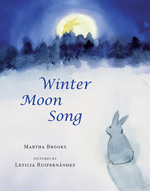 The author learned from a Lakota Indian elder this tale based on brightening the darkest month of the year when the rabbit in the moon appears. In an author’s note at the end she includes that this tale also has roots in China, Korea, and Japan. The story begins as a young rabbit learns the Winter Moon Song. As the young rabbit walks home from rehearsing the song, he stops under the forest cover to observe the moon and is emotionally moved to sing the song, as it should be in nature. The story/song unfolds when Great Mother, Creator Rabbit, saves a young rabbit that has sacrificed himself by throwing himself into a boiling stew pot but Great Mother rescues him and hurls him into the moon where he appears every year during the dark months of winter. The soft watercolor gray and blue illustrations reflect the wintery snow and this subtle tale is a quiet myth to nature and winter.
The author learned from a Lakota Indian elder this tale based on brightening the darkest month of the year when the rabbit in the moon appears. In an author’s note at the end she includes that this tale also has roots in China, Korea, and Japan. The story begins as a young rabbit learns the Winter Moon Song. As the young rabbit walks home from rehearsing the song, he stops under the forest cover to observe the moon and is emotionally moved to sing the song, as it should be in nature. The story/song unfolds when Great Mother, Creator Rabbit, saves a young rabbit that has sacrificed himself by throwing himself into a boiling stew pot but Great Mother rescues him and hurls him into the moon where he appears every year during the dark months of winter. The soft watercolor gray and blue illustrations reflect the wintery snow and this subtle tale is a quiet myth to nature and winter.
—Karen Hildebrand, Ohio Library and Reading Consultant
Johnston, Tony. (2014). Winter is Coming. Illus. by Jim LaMarche. New York: Simon & Schuster Books for Young Readers.
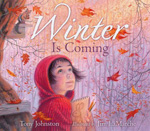 Sitting from her vantage point in a tree on her family’s farm, a young girl uses sketchpad and pencils to observe the changing season as fall turns into winter. She quietly draws a red fox, a lynx, and a family of skunks, woodpeckers, a mother bear with her cub, rabbits, a doe with two fawns, chipmunks, Canada geese and wild turkeys. She watches as the animals prepare for winter—some foraging for food while others move into formation to fly south. LaMarche’s acrylics, colored pencils, and opaque inks are the perfect media to represent beautiful autumn colors, as fall becomes winter. The poetic language of the telling matches the magic of color and most double page spreads end with the phrase, “winter is coming.”
Sitting from her vantage point in a tree on her family’s farm, a young girl uses sketchpad and pencils to observe the changing season as fall turns into winter. She quietly draws a red fox, a lynx, and a family of skunks, woodpeckers, a mother bear with her cub, rabbits, a doe with two fawns, chipmunks, Canada geese and wild turkeys. She watches as the animals prepare for winter—some foraging for food while others move into formation to fly south. LaMarche’s acrylics, colored pencils, and opaque inks are the perfect media to represent beautiful autumn colors, as fall becomes winter. The poetic language of the telling matches the magic of color and most double page spreads end with the phrase, “winter is coming.”
—Karen Hildebrand, Ohio Library and Reading Consultant
McCarthy, Meghan. (2015). Earmuffs for Everyone!: How Chester Goodwood Became Known as the Inventor of Earmuffs. New York: Simon & Schuster.
 This is the “true” story of how Chester Goodwood did NOT invent earmuffs! Author Meghan McCarthy researched how Chester Goodwood is credited for this invention but his accomplishment is that he actually improved the design of earmuffs and applied for the patent and is now somewhat inaccurately celebrated for inventing this warm winter headpiece. The town of Farmington, Maine, annually has a parade at the beginning of each December where all the participants, people, cars, trucks and buses, all wear earmuffs to commemorate Chester Goodwood’s “invention.” Actually, McCarthy has detailed the historical significance of how inventions become legal property for their creators and the importance of patents and protecting the creative rights of inventors, or those ingenious people who improve upon an existing idea. McCarthy includes the back matter of the story including two photographs; one is a photo of the Chester Greenwood Day parade in Farmington and the other is Greenwood himself, wearing earmuffs. Though this story is not so much about winter and snow as it is about history, inventions and inventors, this season is the best time to read the book to children to provide a discussion about the questionable accuracy of history or a great addition to those units of study on inventions.
This is the “true” story of how Chester Goodwood did NOT invent earmuffs! Author Meghan McCarthy researched how Chester Goodwood is credited for this invention but his accomplishment is that he actually improved the design of earmuffs and applied for the patent and is now somewhat inaccurately celebrated for inventing this warm winter headpiece. The town of Farmington, Maine, annually has a parade at the beginning of each December where all the participants, people, cars, trucks and buses, all wear earmuffs to commemorate Chester Goodwood’s “invention.” Actually, McCarthy has detailed the historical significance of how inventions become legal property for their creators and the importance of patents and protecting the creative rights of inventors, or those ingenious people who improve upon an existing idea. McCarthy includes the back matter of the story including two photographs; one is a photo of the Chester Greenwood Day parade in Farmington and the other is Greenwood himself, wearing earmuffs. Though this story is not so much about winter and snow as it is about history, inventions and inventors, this season is the best time to read the book to children to provide a discussion about the questionable accuracy of history or a great addition to those units of study on inventions.
—Karen Hildebrand, Ohio Library and Reading Consultant
McCarty, Peter. (2014). First Snow. New York: Balzer + Bray (release date Jan. 6, 2015).
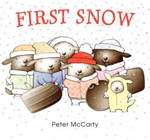 Caldecott Honor-winning Peter McCarty has returned with a first look at snow told through the eyes of his animal characters, this time featuring a dog named Pedro, who has come a long way to visit his cousins in the north. When his creature cousins and their friends get excited about the first now, Pedro is not so sure. It’s cold! But as they bundle up in warm clothes and show Pedro how to catch snowflakes on their tongues and make snow angels and go sledding, the world of winter and snow opens up for Pedro as well as the fun things to do. Though some of these activities like sledding also appear to be a bit scary, Pedro’s new friends help him “slide” into these new experiences. Fans of McCarty will recognize characters from earlier books, Chloe (2012) and Henry in Love (2010). Through the encouragement and kindness of Pedro’s cousins and new friends, they help him overcome the cold and encourage him to try something new even if he is afraid.
Caldecott Honor-winning Peter McCarty has returned with a first look at snow told through the eyes of his animal characters, this time featuring a dog named Pedro, who has come a long way to visit his cousins in the north. When his creature cousins and their friends get excited about the first now, Pedro is not so sure. It’s cold! But as they bundle up in warm clothes and show Pedro how to catch snowflakes on their tongues and make snow angels and go sledding, the world of winter and snow opens up for Pedro as well as the fun things to do. Though some of these activities like sledding also appear to be a bit scary, Pedro’s new friends help him “slide” into these new experiences. Fans of McCarty will recognize characters from earlier books, Chloe (2012) and Henry in Love (2010). Through the encouragement and kindness of Pedro’s cousins and new friends, they help him overcome the cold and encourage him to try something new even if he is afraid.
—Karen Hildebrand, Ohio Library and Reading Consultant
Rocco, John. (2014). Blizzard. New York: Disney-Hyperion.
 Based on the author’s boyhood experience during the Blizzard of 1978 in Rhode Island, he has recreated the images from the first snowflake to a total transformation of a world covered by several feet of snow. When the snow starts to fall on Monday, school is dismissed early and John and his sister walk home with the snow seeping over the tops of their books. Each day thereafter the snow continues to fall and the snowplow has not been able to get to their street to clear the way. Since the front door is drifted shut, the kids climb out the window to play in the snow and create snow forts and tunnels. By the end of the week it is not so fun any more and food supplies are running low. John offers to make a trip to the store after convincing his parents that he learned winter survival skills from his Arctic Survival book. Converting tennis rackets into snowshoes, John sets out on his snowy adventure. A double page gatefold spread shows his trek through the snow, stopping at the homes of neighbors to check on their needs from cat food to peanut butter. Rocco’s digitally rendered watercolor and colored pencil illustrations create the beautiful images of mounds of snow as John drags his sled full of supplies to the neighborhood and becomes a local hero.
Based on the author’s boyhood experience during the Blizzard of 1978 in Rhode Island, he has recreated the images from the first snowflake to a total transformation of a world covered by several feet of snow. When the snow starts to fall on Monday, school is dismissed early and John and his sister walk home with the snow seeping over the tops of their books. Each day thereafter the snow continues to fall and the snowplow has not been able to get to their street to clear the way. Since the front door is drifted shut, the kids climb out the window to play in the snow and create snow forts and tunnels. By the end of the week it is not so fun any more and food supplies are running low. John offers to make a trip to the store after convincing his parents that he learned winter survival skills from his Arctic Survival book. Converting tennis rackets into snowshoes, John sets out on his snowy adventure. A double page gatefold spread shows his trek through the snow, stopping at the homes of neighbors to check on their needs from cat food to peanut butter. Rocco’s digitally rendered watercolor and colored pencil illustrations create the beautiful images of mounds of snow as John drags his sled full of supplies to the neighborhood and becomes a local hero.
—Karen Hildebrand, Ohio Library and Reading Consultant
Grades 3-5
Duey, Kathleen and Karen A. Bale. (2014). Blizzard. (Survivor Series, Book #3). New York: Aladdin/Simon and Schuster.
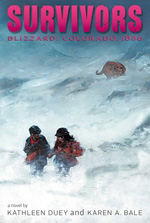 Set in 1886 in Estes Park, CO, Haydn has come to visit his cousin Maggie and her parents. This isn’t exactly a social visit. Haydn has been expelled from his school and Maggie finds his city ways and surly personality difficult. When Maggie’s father is injured and her mother takes him into town to see the doctor, the situation leaves Maggie alone with Haydn. Things don’t go well and Haydn has a fight with Maggie. He runs off and decides to find the train station and leave. When Maggie learns that Haydn never arrived at the train station she knows something is wrong and has to go find him. She sets off into the mountain wilderness and luckily finds him, but a winter storm has descended upon the mountain and they must put aside their argumentative ways and find a way to work together to survive.
Set in 1886 in Estes Park, CO, Haydn has come to visit his cousin Maggie and her parents. This isn’t exactly a social visit. Haydn has been expelled from his school and Maggie finds his city ways and surly personality difficult. When Maggie’s father is injured and her mother takes him into town to see the doctor, the situation leaves Maggie alone with Haydn. Things don’t go well and Haydn has a fight with Maggie. He runs off and decides to find the train station and leave. When Maggie learns that Haydn never arrived at the train station she knows something is wrong and has to go find him. She sets off into the mountain wilderness and luckily finds him, but a winter storm has descended upon the mountain and they must put aside their argumentative ways and find a way to work together to survive.
—Karen Hildebrand, Ohio Library and Reading Consultant
Giff, Patricia Reilly. (2014). Winter Sky. New York: Wendy Lamb Books.
 Siria was named after the star Sirius, after the brightest star of winter, when she was born on New Year’s Day. Sadly, her mother passes away when Siria is a small child and is now the only child of her firefighter father who she desperately wants to protect him and keep safe. When sirens blare to announce a fire and her father speeds out of their seventh-story apartment, Siria sneaks out after him to go to the fire and secretly watch to make sure he is not hurt. Another layer of the story is the friendship Siria has, especially among the people who care for and watch over her in their apartment building. Her friend, Douglas, used to sneak out and go with her to the fires, in addition to a stray dog she has managed to attract. Suddenly, small fires are being set around town and Siria recognizes that these fires are the work of an arsonist. She decides to follow this pattern of fires and conduct a search of her own to find the guilty party.
Siria was named after the star Sirius, after the brightest star of winter, when she was born on New Year’s Day. Sadly, her mother passes away when Siria is a small child and is now the only child of her firefighter father who she desperately wants to protect him and keep safe. When sirens blare to announce a fire and her father speeds out of their seventh-story apartment, Siria sneaks out after him to go to the fire and secretly watch to make sure he is not hurt. Another layer of the story is the friendship Siria has, especially among the people who care for and watch over her in their apartment building. Her friend, Douglas, used to sneak out and go with her to the fires, in addition to a stray dog she has managed to attract. Suddenly, small fires are being set around town and Siria recognizes that these fires are the work of an arsonist. She decides to follow this pattern of fires and conduct a search of her own to find the guilty party.
—Karen Hildebrand, Ohio Library and Reading Consultant
Houts, Michelle. (2014). Winterfrost. Candlewick Press.
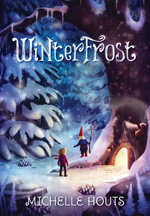 Based on the Danish folkore characters called nisse folk, small gnomelike creatures, this story is set on the island of Lolland in Denmark. Folk tradition has it that nisse inhabit the homes, barns and forests of Denmark and every year on Christmas Eve, humans are to leave a bowl of rice pudding for the nisse.
Based on the Danish folkore characters called nisse folk, small gnomelike creatures, this story is set on the island of Lolland in Denmark. Folk tradition has it that nisse inhabit the homes, barns and forests of Denmark and every year on Christmas Eve, humans are to leave a bowl of rice pudding for the nisse.
As the story opens, 11-year-old Bettina Larsen’s parents are called away on Christmas Eve and Bettina is left to care for the house and farm and, more importantly, her baby sister, Pia. In their rush, Bettina’s parents have forgotten the traditional bowl of rice pudding for the nisse folk. When Pia disappears, Bettina realizes the oversight and goes out into the harsh winter to search for her baby sister.
When she begins her search she finds a nisse family that help her find Pia and Bettina is able to help the nisse in healing an old family wound. The story is told in alternating chapters between Bettina and Klaaka, the nisse who lives in the barn and is upset at not receiving his holiday rice pudding and creating all the trouble. Written in the folkloric language and style of old tales, young readers will enjoy the tiny lives of the nisse and appreciate the spunk and courage displayed by Bettina as she solves the problem of the troublesome Klaaka.
—Karen Hildebrand, Ohio Library and Reading Consultant
Sidman, Joyce. (2014). Winter Bees and Other Poems of the Cold. Illus. by Rick Allen. Boston, MA: Houghton Mifflin Harcourt.
 From award-winning poet Joyce Sidman, thoughtful poems of animals in winter are presented through verse and the wintery soft mixed media including hand-colored linoleum block prints of Rick Allen.
From award-winning poet Joyce Sidman, thoughtful poems of animals in winter are presented through verse and the wintery soft mixed media including hand-colored linoleum block prints of Rick Allen.
Each double-page spread features a poem, the scientific information to provide background for the featured animal and an illustration to serve as the backdrop. Though most of the poems are about familiar animals, Sidman has included a few poems about lesser known snow critters like springtails, or snow fleas. Edging into winter the tundra swans’ poem opens the book and readies the animals for winter. The snakes begin to coil and hibernate, the moose and wolves tough it out, the bees, birds and other underground creatures settle in for hibernating through the cold months ahead. The beautiful imagery of words and pictures, with the added benefit of scientific facts, make this another outstanding book from the recipient of the recent NCTE Award for Excellence in Poetry for Children. Visit the author’s website for more background information and uses of poetry with children. Teachers will appreciate the feature article on this book at the Poetry for Children blog that will direct them to the discussion guide created by Sylvia Vardell.
—Karen Hildebrand, Ohio Library and Reading Consultant
Smith, Alex T. (2014). Claude on the Slopes. Atlanta, GA: Peachtree Press.
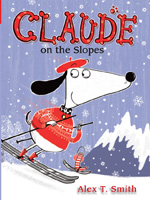 For those early readers of chapter books, Claude is back and this time he is at Snowy Mountain learning to ski. Accompanied by his friend, Sir Bobblysock, who is always ready for any situation, the two friends are off to a winter holiday on the slopes. Fun turns to danger as Claude’s loud voice causes an avalanche and they are threatened with being buried under tons of snow. The cartoon-like illustrations and short chapters are perfect for emerging readers. Enjoy more about all the Claude books and his adventures at the author’s blog.
For those early readers of chapter books, Claude is back and this time he is at Snowy Mountain learning to ski. Accompanied by his friend, Sir Bobblysock, who is always ready for any situation, the two friends are off to a winter holiday on the slopes. Fun turns to danger as Claude’s loud voice causes an avalanche and they are threatened with being buried under tons of snow. The cartoon-like illustrations and short chapters are perfect for emerging readers. Enjoy more about all the Claude books and his adventures at the author’s blog.
—Karen Hildebrand, Ohio Library and Reading Consultant
Grades 6-8
Freitas, Donna. (2014). Gold Medal Winter. New York: Arthur A. Levine Books/Scholastic Imprint.
 The companion volume to the author’s Gold Medal Summer (2012), this book features Dominican-American figure skater Esperanza Flores, newly acquired member of the U.S. Olympic team. When the original team member is injured and Esperanza is picked to take her place, complications ensue as she tries to find her place on the team. Resentment from other team mates, the constant pressure from public media, and a few interesting flirtations with a member of the team complicated by a certain hockey player make life even more troublesome. Espi is training diligently to perfect a new jump that will help her attain her medal goal but there are so many distractions she is having trouble concentrating on her workouts. Double the pressure as Espi wants to make a great showing as the first Latina to be part of the U. S. Olympic Figure Skating Team. Followers of figure skating will enjoy this story in addition to young readers who like the sports/romance genre.
The companion volume to the author’s Gold Medal Summer (2012), this book features Dominican-American figure skater Esperanza Flores, newly acquired member of the U.S. Olympic team. When the original team member is injured and Esperanza is picked to take her place, complications ensue as she tries to find her place on the team. Resentment from other team mates, the constant pressure from public media, and a few interesting flirtations with a member of the team complicated by a certain hockey player make life even more troublesome. Espi is training diligently to perfect a new jump that will help her attain her medal goal but there are so many distractions she is having trouble concentrating on her workouts. Double the pressure as Espi wants to make a great showing as the first Latina to be part of the U. S. Olympic Figure Skating Team. Followers of figure skating will enjoy this story in addition to young readers who like the sports/romance genre.
—Karen Hildebrand, Ohio Library and Reading Consultant
Kerr, Philip. (2014). The Winter Horses. New York: Alfred A. Knopf.
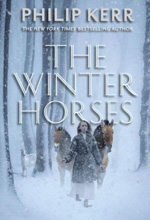 This Holocaust story is set in 1941, in wintery Ukraine, Russia, during World War II. Young Jewish teen Kalinka has lost everything that matters to her. She is running from the Nazis who hunt her and is living on the steppe in Ukraine where she has encountered two Przewalski’s horses on the Askaniya-Nova preserve where she is hiding. These wild and rare horses have a prehistoric legacy and have never been domesticated. Kalinka is able to bond with these endangered creatures but the Nazis are determined to destroy them all as inferior animals. Award-winning adult author Philip Kerr departs from his adult writing to create this story for younger readers. When the SS take over the preserve they order Max, the caretaker, to destroy all of the animals. When Max discovers Kalinka and the Przewalski horses, they escape together to face the harsh wintery wilderness of Ukraine. The supernatural bond between Kalinka and the horses helps save their lives as the story takes on characteristics of the fantasy elements of folklore.
This Holocaust story is set in 1941, in wintery Ukraine, Russia, during World War II. Young Jewish teen Kalinka has lost everything that matters to her. She is running from the Nazis who hunt her and is living on the steppe in Ukraine where she has encountered two Przewalski’s horses on the Askaniya-Nova preserve where she is hiding. These wild and rare horses have a prehistoric legacy and have never been domesticated. Kalinka is able to bond with these endangered creatures but the Nazis are determined to destroy them all as inferior animals. Award-winning adult author Philip Kerr departs from his adult writing to create this story for younger readers. When the SS take over the preserve they order Max, the caretaker, to destroy all of the animals. When Max discovers Kalinka and the Przewalski horses, they escape together to face the harsh wintery wilderness of Ukraine. The supernatural bond between Kalinka and the horses helps save their lives as the story takes on characteristics of the fantasy elements of folklore.
—Karen Hildebrand, Ohio Library and Reading Consultant
Grades 9-12
Hubbard, Jenny. (2014). And We Stay. New York: Delacorte Press.
 It is a cold January of 1995 when Emily Beam transfers to the Amherst School for Girls in Amherst, MA. Why has she made this school switch in the middle of the year all her classmates are asking? Author Jenny Hubbard has written a beautiful novel in verse and prose as the story of Emily unfolds. Just weeks before at her old school, Emily learns she is pregnant. She decides to break up with her boyfriend and in his tragically depressed state of mind, he walks into the school library to find Emily, threaten her with a gun, but ends up shooting himself in front of her. Pressured by her parents to get an abortion and a new start for her young teen life, Emily leaves her school and transfers to Amherst. With the omniscient presence of the poet Emily Dickinson in Amherst and feeling a connection to her namesake, Emily Beam writes about her life, her recent tragedy, being pregnant, and starting over. Making new friends and using her writing to sort out her emotions present a story of a young girl facing the future with courage in the face of tragedy.
It is a cold January of 1995 when Emily Beam transfers to the Amherst School for Girls in Amherst, MA. Why has she made this school switch in the middle of the year all her classmates are asking? Author Jenny Hubbard has written a beautiful novel in verse and prose as the story of Emily unfolds. Just weeks before at her old school, Emily learns she is pregnant. She decides to break up with her boyfriend and in his tragically depressed state of mind, he walks into the school library to find Emily, threaten her with a gun, but ends up shooting himself in front of her. Pressured by her parents to get an abortion and a new start for her young teen life, Emily leaves her school and transfers to Amherst. With the omniscient presence of the poet Emily Dickinson in Amherst and feeling a connection to her namesake, Emily Beam writes about her life, her recent tragedy, being pregnant, and starting over. Making new friends and using her writing to sort out her emotions present a story of a young girl facing the future with courage in the face of tragedy.
—Karen Hildebrand, Ohio Library and Reading Consultant
Kirkpatrick, Katherine. (2014). Between Two Worlds. New York: Wendy Lamb Books.
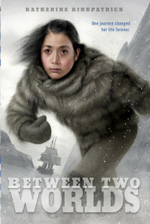 Set in 1890-1900’s Itta, Greenland, 16-year-old Inuit narrator Eqariusaq tells the story of the Robert E. Peary expedition to the North Pole. Based on historical facts from the period, as a small child Eqariusaq spent a year in the United States with the Peary family. Her parents returned years later but never returned as they were killed while in the U.S. in a scandalous incident. As the Peary expedition arrives, it turns out that it is the supply ships that landed and have Mrs. Peary and her daughter, Marie, aboard, though Peary himself has gone ahead. They are excited to reunite with Eqarisusaq, who they call Billy Bah. Billy Bah is now the intermediary between her Inuit family and the explorers. She is often caught between the two cultures. In accordance with Inuit custom, Billy Bah has an arranged marriage to lazy Angulluk. A mature theme within this book is the trading of wives for money or favors and Angulluk trades Billy Bah to an American sailor. Again, Billy Bah is caught between custom and culture. She actually begins to love this red-haired American sailor. As Billy Bah and fellow Inuits move north to assist the expedition in finding Peary and his crew, their lives are often in peril. When Peary’s expedition is icebound for months the skills of the Inuit save the travelers on several occasions. This mature story is one of courage, cross-cultural examinations and decisions about a future life for Billy Bah.
Set in 1890-1900’s Itta, Greenland, 16-year-old Inuit narrator Eqariusaq tells the story of the Robert E. Peary expedition to the North Pole. Based on historical facts from the period, as a small child Eqariusaq spent a year in the United States with the Peary family. Her parents returned years later but never returned as they were killed while in the U.S. in a scandalous incident. As the Peary expedition arrives, it turns out that it is the supply ships that landed and have Mrs. Peary and her daughter, Marie, aboard, though Peary himself has gone ahead. They are excited to reunite with Eqarisusaq, who they call Billy Bah. Billy Bah is now the intermediary between her Inuit family and the explorers. She is often caught between the two cultures. In accordance with Inuit custom, Billy Bah has an arranged marriage to lazy Angulluk. A mature theme within this book is the trading of wives for money or favors and Angulluk trades Billy Bah to an American sailor. Again, Billy Bah is caught between custom and culture. She actually begins to love this red-haired American sailor. As Billy Bah and fellow Inuits move north to assist the expedition in finding Peary and his crew, their lives are often in peril. When Peary’s expedition is icebound for months the skills of the Inuit save the travelers on several occasions. This mature story is one of courage, cross-cultural examinations and decisions about a future life for Billy Bah.
Lewis, R. C. (2014). Stitching Snow. New York: Hyperion.
 From the genre of re-told fairy tales and science fiction, the story of Snow White is transformed when Princess Snow goes missing. Essie, or Princess Snow, is living on the frozen planet of Thanda. Her violent father, King Matthias and her evil stepmother want her back. As the years go by, interplanetary war is rising and bands of revolutionaries are roaming the planets soliciting help. When a space ship crash-lands on Thanda, Essie is able to help the downed pilot, Dane. Essie uses her special skills repairing, or “stitching” all kinds of machinery, robots and drones. The seven drones work the mines while she maintains their repairs. As a very competitive friendship and eventual romance begins to flourish between Essie and Dane, the true story of running away from her home planet and her abusive father are revealed. This fast-paced sci-fi spinoff from Snow White will keep fans of Marissa Meyer’s Cinder and Cress enjoying a new world and fresh look at an old tale. Teachers might like to check out this site for fairytale resources around the world.
From the genre of re-told fairy tales and science fiction, the story of Snow White is transformed when Princess Snow goes missing. Essie, or Princess Snow, is living on the frozen planet of Thanda. Her violent father, King Matthias and her evil stepmother want her back. As the years go by, interplanetary war is rising and bands of revolutionaries are roaming the planets soliciting help. When a space ship crash-lands on Thanda, Essie is able to help the downed pilot, Dane. Essie uses her special skills repairing, or “stitching” all kinds of machinery, robots and drones. The seven drones work the mines while she maintains their repairs. As a very competitive friendship and eventual romance begins to flourish between Essie and Dane, the true story of running away from her home planet and her abusive father are revealed. This fast-paced sci-fi spinoff from Snow White will keep fans of Marissa Meyer’s Cinder and Cress enjoying a new world and fresh look at an old tale. Teachers might like to check out this site for fairytale resources around the world.
—Karen Hildebrand, Ohio Library and Reading Consultant
Raasch, Sara. (2014). Snow Like Ashes. New York: Balzer + Bray/HarperCollins.
 Enter the fantasy realm of the Kingdom of Winter from debut author, Sara Raasch. Eight survivors escaped the takeover of the kingdom 16 years earlier when everyone was enslaved and left with no leadership and no magic with which to fight back. Young Meira was orphaned during the war and has been a refugee ever since. She has trained to be a warrior and decides to embark on a journey to find other rebels willing to fight and search for her half of an ancient locket, the Royal Conduit, said to hold the power to help win back the kingdom. Her weapon of choice is the chakram, featured on the cover of the book. Meira’s best friend, Mather, is also the young man she is in love with as well as being the future king of Winter. As their rebel band moves forward to win back the kingdom, Meira is offered as an alliance with the crown prince of Cordell. Relationships are shifting and Meira realizes an awareness of the political aspects of warring neighbors to find peace—or not? This romantic space good versus evil adventure provides a fast-paced read with layers of complex story lines.
Enter the fantasy realm of the Kingdom of Winter from debut author, Sara Raasch. Eight survivors escaped the takeover of the kingdom 16 years earlier when everyone was enslaved and left with no leadership and no magic with which to fight back. Young Meira was orphaned during the war and has been a refugee ever since. She has trained to be a warrior and decides to embark on a journey to find other rebels willing to fight and search for her half of an ancient locket, the Royal Conduit, said to hold the power to help win back the kingdom. Her weapon of choice is the chakram, featured on the cover of the book. Meira’s best friend, Mather, is also the young man she is in love with as well as being the future king of Winter. As their rebel band moves forward to win back the kingdom, Meira is offered as an alliance with the crown prince of Cordell. Relationships are shifting and Meira realizes an awareness of the political aspects of warring neighbors to find peace—or not? This romantic space good versus evil adventure provides a fast-paced read with layers of complex story lines.
—Karen Hildebrand, Ohio Library and Reading Consultant
These reviews are submitted by members of the International Reading Association's Children's Literature and Reading Special Interest Group (CL/R SIG) and are published weekly on Reading Today Online.